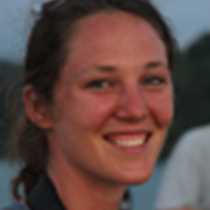Golfo Dulce & Casa Orquideas
Welcome to Costa Rica! Early this morning, after sailing through the night, we arrived at a small port in Gulfo Dulce called Golfito. As we listened to a chorus of songbirds and watched the sun come up over the horizon we cleared customs, took on water, fuel and clean laundry. During breakfast we repositioned the ship to a place called Casa Orquideas, a beautiful botanical garden that expatriates Ron and Trudy MacAllister graciously shared with us. The Macallister’s have lived in Costa Rica for over 30 years. During that time they have transformed six of their 75 acres piece of land into a diverse ecosystem filled with numerous species of orchids, fruit trees, ornamental plants, flowers and vegetables. Their efforts have attracted many species of birds, and we spent part of the morning watching two pairs of scarlet macaws feeding on palm fruit, as well as listening to toucans as they called from the treetops. Beneath the draping fronds of a palm tree, we also spied several tent-making bats hanging upside-down from their hooked claws. Their dog-like faces peered curiously at us as they gently swayed side to side.
Golfo Dulce is well known as being hot and humid, so to cool off before returning to the ship, we took a quick dip from the pebbly beach that fronts Casa Orquideas. Although still warm, the water felt refreshing. Just as we were leaving the shore to return to the National Geographic Sea Lion, a naturalist spotted the scaly form of a bird-eating snake. Thankfully he was not in the middle of a meal.
During lunch we repositioned the ship once again to another anchorage within Golfo Dulce. Our afternoon activities included Zodiac cruises among the mangroves and along the forested edge of the Gulf, or simply relaxing on the sundeck with a good book. Several Zodiac passengers were lucky enough to see howler monkeys and the more elusive Central American squirrel monkey. Squirrel monkeys spend two-thirds to three-fourths of their day in trees foraging for ripe fruits and insects. They have been listed as endangered under the CITES act due to deforestation and habitat loss from development and encroaching agriculture. It was a treat to see them in their natural environment!
Tomorrow we will continue our adventures and exploration in Costa Rica with a visit to Corcovado National Park, a stunning example of lush rainforest and white sandy beaches.




